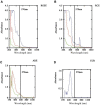DRAQ7 as an Alternative to MTT Assay for Measuring Viability of Glioma Cells Treated With Polyphenols
- PMID: 32988864
- PMCID: PMC7116225
- DOI: 10.21873/anticanres.14553
DRAQ7 as an Alternative to MTT Assay for Measuring Viability of Glioma Cells Treated With Polyphenols
Abstract
Background/aim: The tetrazolium-based MTT cytotoxicity assay is well established for screening putative anti-cancer agents. However, it has limitations including lack of reproducibility with glioma cells treated with polyphenols. The aim of this study was to evaluate whether a flow cytometric assay with the anthraquinone, DRAQ7, was a better alternative than the colorimetric MTT assay for measuring cell viability.
Materials and methods: Two glioma cell lines (IPSB-18, U373) and 1 pancreatic cancer cell line (AsPC-1) were treated with 4 polyphenols, namely red grape seed extract, red clover extract, anthocyanin-rich extract and curcumin. Cell viability was assessed using MTT assay and DRAQ7 staining.
Results: Limitations of MTT assay included lack of sensitivity and interference with the structure and absorbance spectra of polyphenols. Also, DMSO was toxic to glioma cells. Microscopic observations of cells treated with polyphenols confirmed the range of IC50 values evaluated by DRAQ7, but not by the MTT assay.
Conclusion: DRAQ7 is a better alternative than MTT for measuring viability of glioma cells treated with brightly coloured polyphenols.
Keywords: DRAQ7; Glioma; MTT; flow cytometry; polyphenols; viability.
Copyright© 2020, International Institute of Anticancer Research (Dr. George J. Delinasios), All rights reserved.
Conflict of interest statement
None declared.
Figures





References
MeSH terms
Substances
Grants and funding
LinkOut - more resources
Full Text Sources
